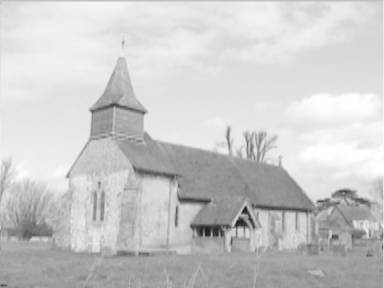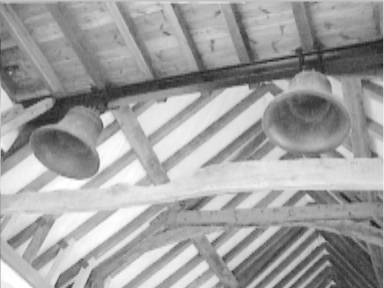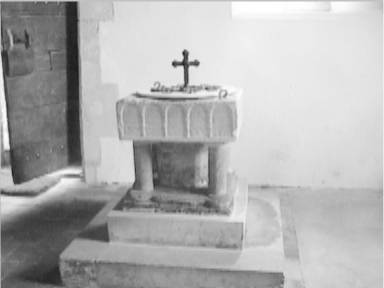![]()

![]()
27. St Peter Ad Vincula Colemore

This church, set in the heart of rolling farmlands south of East Tisted, was sadly declared redundant in 1972, but the building remains consecrated, partially furnished and in a good state of repair.
At the west end of the nave two large bells hang under the bell turret. One, on the south side, was cast at Wokingham in 1380, the other in Reading in 1627. Alongside a wooden ladder up to the belfry is clearly marked R.W.1694. Under the bells stands an attractive twelfth century font of Purbeck marble supported on a central drum. The nave windows are early fourteenth century though restored in 1845. There is no electricity in the church and illumination is provided by three attractive six candle iron chandeliers.

The original Norman building was cruciform in shape but in 1672 the South transept fell into ruin and was demolished. The North transept today contains a rather sorry looking Jacobean communion table standing under a fourteenth century window. Alongside there is a large squint through the wall to the chancel and a twelfth century doorway in the west wall.
The chancel was rebuilt in 1875 but has an eleventh century window on the north side and below a large recess in which the Easter sepulchre was placed. The three light East Window dates from the fifteenth century and has painted decoration surrounding it. The Victorian glass depicts the Resurrection in the centre with St Peter in chains and St John the Apostle on either side. In the south wall is a round headed piscina.

Just in front of the altar are some interesting ledger slabs. Three of them relate to former rectors, two of whom had remarkably long tenures in the parish. The earliest, on the south side, commemorates Richard Pocock L.L.B. who died in 1718 aged 83 and his wife Constance. He served 59 years as Rector 'a man of singular probity, eminent piety and great charity'. The second slab commemorates the Revd Thomas Harrison who died in 1766 at the early age of 32. 'He through life supported his station with a becoming dignity and after 2 years illness patiently submitted to the just Decree of Heaven'. Finally on the north side is the memorial to the Rev. James Cookson who also served 59 years as Rector and was 'the oldest magistrate in the County'. He died in January 1835 aged 83. The Cookson family memorial in white marble can be seen in the south west corner of the nave. It is a sad list of early deaths, including the Rector's son Lt. George Bryan Cookson of 8 Regiment of Native Infantry who died at Dinapore in the East Indies in 1814 aged 22. A Captain John Cookson died in 1819 aged 31, Thomas in 1834 aged 30, a daughter Ann Constantia in 1821 aged 21 and finally the Rector's wife Sarah dying in 1828 aged 50. On the opposite North wall is an older Latin Memorial to John and Philipp Pocock. John died in 1692 aged 24 and Philipp in 1700 aged 30. They must surely be the sons of the Rector Richard Pocock buried near the chancel, yet another reminder of the shortness of life in those earlier centuries.
All in all a fine little church surrounded by glorious countryside, well cared for by the Redundant Churches Fund and well worth a detour to find it.
written by John Symonds
![]() Return to the Easter 1999 Features page
Return to the Easter 1999 Features page
![]() return to Home page and main index
return to Home page and main index
page last updated 1 APRIL 1999